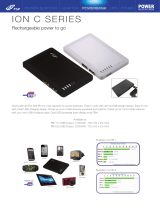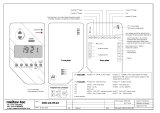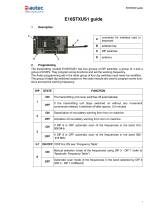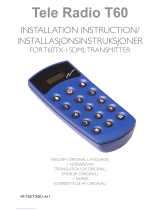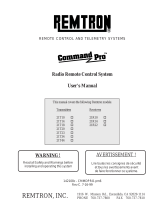Page is loading ...

Flex 12EM EU System
Radio Control Equipment
Instruction Manual
0-FLEX-12EM-EU R0
April 2015
© Copyright 2015 Magnetek Material Handling

Flex 12EM System Instruction Manual
April 2015
2 of 36
Service Information
Your New Radio System
Thank you for your purchase of Magnetek’s Enrange™ Flex EM radio remote control system. Without a
doubt, our Flex EM system is the ultimate solution for providing precise, undeterred, and safe control of
your material.
If your product ever needs modification or service, please contact one of our representatives at the
following locations:
U.S. Service Information
For questions regarding service or technical information contact:
+1.866.MAG.SERV
+(1.866.624.7378)
World Headquarters:
Magnetek, Inc.
N49 W13650 Campbell Drive
Menomonee Falls, WI 53051
Telephone: +1.800.288.8178
Website: www.magnetek.com
e-mail: MHCustomerservice@magnetek.com
Fax Numbers:
Main: +1.800.298.3503
Sales: +1.262.783.3510
Service: +1.262.783.3508
Canada Service Information:
4090B Sladeview Crescent
Mississauga, Ontario
L5L 5Y5 Canada
Phone: +1.800.792.7253
Fax: +1.905.828.5707
EU Market Contact:
Brian Preston
Magnetek (UK) Ltd.
Unit 3 Bedford Business Centre
Mile Road
Bedford, MK42 9TW UK
Phone: +44.1234.349191
Fax: +44.1234.268955
Magnetek, Inc. has additional satellite locations for Canada and the United States. For more information,
please visit http://www.magnetek.com.
©2015 MAGNETEK
All rights reserved. This notice applies to all copyrighted materials included with this product, including,
but not limited to, this manual and software embodied within the product. This manual is intended for the
sole use of the person(s) to whom it was provided, and any unauthorized distribution of the manual or
dispersal of its contents is strictly forbidden. This manual may not be reproduced in whole or in part by
any means whatsoever without the expressed written permission of MAGNETEK.

Flex 12EM System Instruction Manual
April 2015
3 of 36
PRODUCT MANUAL SAFETY INFORMATION
Magnetek, Inc. (Magnetek) offers a broad range of radio remote control products, control products and
adjustable frequency drives, and industrial braking systems for material handling applications. This
manual has been prepared by Magnetek to provide information and recommendations for the installation,
use, operation and service of Magnetek’s material handling products and systems (Magnetek Products).
Anyone who uses, operates, maintains, services, installs or owns Magnetek Products should know,
understand and follow the instructions and safety recommendations in this manual for Magnetek
Products.
The recommendations in this manual do not take precedence over any of the following requirements
relating to cranes, hoists lifting devices or other material handling equipment which use or include
Magnetek Products:
Instructions, manuals, and safety warnings of the manufacturers of the equipment where the
radio system is used,
Plant safety rules and procedures of the employers and the owners of facilities where the
Magnetek Products are being used,
Regulations issued by the Occupational Health and Safety Administration (OSHA),
Applicable local, state or federal codes, ordinances, standards and requirements, or
Safety standards and practices for the industries in which Magnetek Products are used.
This manual does not include or address the specific instructions and safety warnings of these
manufacturers or any of the other requirements listed above. It is the responsibility of the owners, users
and operators of the Magnetek Products to know, understand and follow all of these requirements. It is
the responsibility of the employer to make its employees aware of all of the above listed requirements and
to make certain that all operators are properly trained. No one should use Magnetek Products prior to
becoming familiar with and being trained in these requirements and the instructions and safety
recommendations in this manual.
WARRANTY INFORMATION
For information on Magnetek’s product warranties by product type, please visit www.magnetek.com.

Flex 12EM System Instruction Manual
April 2015
4 of 36
Table of Contents
1
INTRODUCTION .......................................................................................................................................... 5
2 RADIO CONTROLLED SAFETY ................................................................................................................. 6
2.1 CRITICAL INSTALLATION CONSIDERATIONS ................................................................................. 7
2.2 GENERAL ............................................................................................................................................ 7
2.3 PERSONS AUTHORIZED TO OPERATE RADIO CONTROLLED CRANES ..................................... 7
2.4 SAFETY INFORMATION AND RECOMMENDED TRAINING FOR RADIO CONTROLLED
EQUIPMENT OPERATORS ............................................................................................................................ 7
2.5 TRANSMITTER UNIT .......................................................................................................................... 8
2.6 PRE-OPERATION TEST ..................................................................................................................... 9
2.7 HANDLING BATTERIES ..................................................................................................................... 9
2.8 OPTIONAL RECHARGEABLE BATTERY CHARGING ...................................................................... 9
2.9 BATTERY DISPOSAL .......................................................................................................................... 9
2.10 CRANE/LIFTING DEVICE SPECIFIC WARNINGS .......................................................................... 10
2.11 SPECIFIC SYSTEM WARNINGS ...................................................................................................... 10
3 GENERAL SYSTEM INFORMATION......................................................................................................... 11
3.1 TRANSMITTER HANDSET ............................................................................................................... 11
3.1.1 External Illustration ........................................................................................................................ 11
3.1.2 Internal Illustration ......................................................................................................................... 12
3.2 RECEIVER UNIT ............................................................................................................................... 13
3.2.1 External Illustration ........................................................................................................................ 13
3.2.2 Internal Illustration ......................................................................................................................... 14
4 FUNCTION SETTINGS .............................................................................................................................. 15
4.1 TRANSMITTER HANDSET ............................................................................................................... 15
4.1.1 System Channel Settings .............................................................................................................. 15
4.1.2 Continuous Transmitting Time Adjustment .................................................................................... 16
4.1.3 Push Button Functions with LED Display Settings ........................................................................ 17
4.1.4 Channel Change via Push Buttons ................................................................................................ 18
4.1.5 Optional 4-Digit Security Code ...................................................................................................... 19
4.1.6 I-CHIP ............................................................................................................................................ 20
4.2 RECEIVER UNIT ............................................................................................................................... 21
4.2.1 System Channel Settings .............................................................................................................. 21
4.2.2 Receiver Auto-Scanning Settings .................................................................................................. 22
4.2.3 Dip-Switch Settings ........................................................................................................................ 23
4.2.4 Jumper Settings ............................................................................................................................. 24
4.2.5 I-CHIP Programming Port .............................................................................................................. 25
4.2.6 Fuse Ratings .................................................................................................................................. 25
5 SYSTEM CHANNELS TABLE .................................................................................................................... 26
6 RECEIVER INSTALLATION ....................................................................................................................... 27
6.1 OUTPUT RELAY CONTACT DIAGRAM ............................................................................................ 27
6.2 PRE-INSTALLATION PRECAUTIONS .............................................................................................. 28
6.3 STEP-BY-STEP INSTALLATION ....................................................................................................... 28
6.4 SYSTEM TESTING ........................................................................................................................... 29
7 OPERATING PROCEDURE ...................................................................................................................... 30
7.1 TRANSMITTER OPERATION ........................................................................................................... 30
7.1.1 General Operating Procedure ....................................................................................................... 30
7.1.2 Automatic Channel Scanning Operating Procedure ...................................................................... 31
7.1.3 Changing Transmitter Batteries ..................................................................................................... 31
7.2 STATUS LIGHT INDICATORS & WARNINGS .................................................................................. 32
7.2.1 Transmitter STATUS Light Indication ............................................................................................. 32
7.2.2 Receiver STATUS Light Indication ................................................................................................. 33
7.2.3 Receiver SQ Light Indication ......................................................................................................... 33
7.2.4 Receiver POWER Light Indication ................................................................................................. 33
7.2.5 Receiver COM Light Indication ...................................................................................................... 33
7.3 TROUBLE SHOOTING TIPS ............................................................................................................. 34
8 SYSTEM SPECIFICATIONS ...................................................................................................................... 35
9 DECLARATION OF CONFORMITY ........................................................................................................... 36

Flex 12EM System Instruction Manual
April 2015
5 of 36
1 INTRODUCTION
The Flex radio remote control systems are designed for control of industrial equipment and machinery such as
overhead traveling cranes, jib cranes, gantry cranes, tower cranes, electric hoists, winches, monorails,
conveyor belts, mining equipment and other material handling equipment where wireless control is preferred.
Each Flex system consists of a transmitter handset and receiver unit. Other standard-equipped accessories
include transmitter waist belt, spare transmitter power key, clear vinyl pouch, “AA” alkaline batteries, compass
direction decal sheet and user’s manual.
List of notable features include:
62 user-programmable channels – Advanced synthesized RF controls with 62 built-in channels;
there are no more fixed channels and fragile quartz crystals to break.
Automatic channel scanning receiver – No more hassle of climbing up the crane to change
receiver channels.
Over one million unique ID codes (20bit) – Each and every Flex system has its own unique ID
codes and serial number; never repeats.
Advanced controls – The Flex system utilizes advanced microprocessor controls with 32bit CRC
and Hamming Code, which provide ultra-fast, safe, precise, and error-free encoding and decoding.
Unique I-CHIP design – The I-CHIP functions in a way that is very similar to SIM cards used on
mobile phones, with the ability to transfer system information and settings from one transmitter to
another without the hassle of resetting the spares.
Reliable push buttons – The in-house designed push buttons with gold-plated contacts are rated
for more than one million press cycles.
Low power consumption – Requires only two “AA” Alkaline batteries for more than 100 hours of
operating time between replacements.
Ultra-durable nylon and fiberglass composite enclosures – Highly resistant to breakage and
deformation even in the most abusive environments.
Full compliance – All systems are fully compliant with the FCC Part-15 Rules, European Directives
(Safety, EMC, R&TTE, Machinery), and Industry Canada Specifications (IC).

Flex 12EM System Instruction Manual
April 2015
6 of 36
2 RADIO CONTROLLED SAFETY
WARNINGS and CAUTIONS
Throughout this document WARNING and CAUTION statements have been deliberately placed to highlight items critical
to the protection of personnel and equipment.
WARNING – A warning highlights an essential operating or maintenance procedure, practice, etc. which if not
strictly observed, could result in injury or death of personnel, or long term physical hazards. Warnings are
highlighted as shown below:
WARNING
CAUTION – A caution highlights an essential operating or maintenance procedure, practice, etc. which if not
strictly observed, could result in damage to, or destruction of equipment, or loss of functional effectiveness.
Cautions are highlighted as shown below:
CAUTION
WARNINGS and CAUTIONS SHOULD NEVER BE DISREGARDED.
The safety rules in this section are not intended to replace any rules or regulations of any applicable local, state, or federal
governing organizations. Always follow your local lockout and tagout procedure when maintaining any radio equipment.
The following information is intended to be used in conjunction with other rules or regulations already in existence. It is
important to read all of the safety information contained in this section before installing or operating the Radio Control
System.

Flex 12EM System Instruction Manual
April 2015
7 of 36
2.1 CRITICAL INSTALLATION CONSIDERATIONS
WARNING
PRIOR TO INSTALLATION AND OPERATION OF THIS EQUIPMENT, READ AND DEVELOP AN UNDERSTANDING OF
THE CONTENTS OF THIS MANUAL AND THE OPERATION MANUAL OF THE EQUIPMENT OR DEVICE TO WHICH
THIS EQUIPMENT WILL BE INTERFACED. FAILURE TO FOLLOW THIS WARNING COULD RESULT IN SERIOUS
INJURY OR DEATH AND DAMAGE TO EQUIPMENT.
FOLLOW YOUR LOCAL LOCKOUT TAGOUT PROCEDURE BEFORE MAINTAINING ANY REMOTE CONTROLLED
EQUIPMENT. ALWAYS REMOVE ALL ELECTRICAL POWER FROM THE EQUIPMENT BEFORE ATTEMPTING ANY
INSTALLATION PROCEDURES. DE-ENERGIZE AND TAGOUT ALL SOURCES OF ELECTRICAL POWER BEFORE
TOUCH-TESTING ANY EQUIPMENT. FAILURE TO FOLLOW THIS WARNING COULD RESULT IN SERIOUS INJURY
OR DEATH AND DAMAGE TO EQUIPMENT.
AFTER INSTALLATION BE SURE TO VERIFY THAT THE TRANSMITTER IS NOT INTERFERING WITH OTHER
EQUIPMENT IN THE AREA. ALSO VERIFY THAT OTHER EQUIPMENT IS NOT INTERFERING WITH THE
TRANSMITTER AND ITS ASSOCIATED EQUIPMENT. FAILURE TO FOLLOW THESE WARNINGS COULD RESULT IN
SERIOUS INJURY OR DEATH AND DAMAGE TO EQUIPMENT.
2.2 GENERAL
Radio controlled equipment operates in several directions. Quite frequently, the equipment is operated in areas where
people are working in close proximity to the equipment. The operator must exercise extreme caution at all times.
Workers must constantly be alert to avoid accidents. The following recommendations have been included to indicate how
careful and thoughtful actions may prevent injuries, damage to equipment, or even save a life.
2.3 PERSONS AUTHORIZED TO OPERATE RADIO
CONTROLLED CRANES
Only properly trained persons designated by management should be permitted to operate radio controlled equipment.
Radio controlled equipment should not be operated by any person who cannot read or understand signs, notices and
operating instructions that pertain to the equipment.
Radio controlled equipment should not be operated by any person with insufficient eyesight or hearing or by any person
who may be suffering from a disorder or illness, is taking any medication that may cause loss of equipment control, or is
under the influence of alcohol or drugs.
2.4 SAFETY INFORMATION AND RECOMMENDED TRAINING
FOR RADIO CONTROLLED EQUIPMENT OPERATORS
Anyone being trained to operate radio controlled equipment should possess as a minimum the following knowledge and
skills before using the radio controlled equipment.
The operator should:
have knowledge of hazards pertaining to equipment operation
have knowledge of safety rules for radio controlled equipment
have the ability to judge distance of moving objects
know how to properly test prior to operation
be trained in the safe operation of the radio transmitter as it pertains to the equipment being operated

Flex 12EM System Instruction Manual
April 2015
8 of 36
have knowledge of the use of equipment warning lights and alarms
have knowledge of the proper storage space for a radio control transmitter when not in use
be trained in transferring a radio control transmitter to another person
be trained how and when to report unsafe or unusual operating conditions
test the transmitter emergency stop and all warning devices prior to operation; testing should be done on each
shift, without a load
be thoroughly trained and knowledgeable in proper and safe operation of the equipment that utilizes the radio
control
know how to keep the operator and other people clear of hazardous areas
know and follow the local lockout and tagout procedures when servicing radio controlled equipment
know and follow all applicable operating and maintenance manuals, safety procedures, regulatory requirements,
and industry standards and codes
The operator shall not:
operate the equipment if the direction of travel or function engaged does not agree with what is indicated on the
controller
operate any damaged or malfunctioning equipment
change any settings or controls without authorization and proper training
remove or obscure any warning or safety labels or tags
leave power on the radio controlled equipment when the equipment is not in operation
operate any equipment using a damaged controller because the unit may be unsafe
operate manual motions with other than manual power
operate radio controlled equipment when low battery indicator is on
WARNING
THE OPERATOR SHOULD NOT ATTEMPT TO REPAIR ANY RADIO CONTROLLER. IF ANY PRODUCT
PERFORMANCE OR SAFETY CONCERNS ARE OBSERVED, THE EQUIPMENT SHOULD IMMEDIATELY BE TAKEN
OUT OF SERVICE AND BE REPORTED TO THE SUPERVISOR. DAMAGED AND INOPERABLE RADIO
CONTROLLER EQUIPMENT SHOULD BE RETURNED TO MAGNETEK FOR EVALUATION AND REPAIR. FAILURE TO
FOLLOW THIS WARNING COULD RESULT IN SERIOUS INJURY OR DEATH AND DAMAGE TO EQUIPMENT.
2.5 TRANSMITTER UNIT
Transmitter switches should never be mechanically blocked ON or OFF. When not in use, the operator should turn the
transmitter OFF. A secure storage space should be provided for the transmitter unit, and the transmitter unit should always
be placed there when not in use. This precaution will help prevent unauthorized people from operating the material
handling equipment.
Spare transmitters should be stored in a secure storage space and only removed from the storage space after the current
transmitter in use has been turned OFF, taken out of the service area and secured.

Flex 12EM System Instruction Manual
April 2015
9 of 36
2.6 PRE-OPERATION TEST
At the start of each work shift, or when a new operator takes control of the equipment, operators should do, as a
minimum, the following steps before making lifts with any equipment:
Test all warning devices.
Test all functions.
Test the transmitter machine stop.
2.7 HANDLING BATTERIES
WARNING
KNOW AND FOLLOW PROPER BATTERY HANDLING, CHARGING AND DISPOSAL PROCEDURES. IMPROPER
BATTERY PROCEDURES CAN CAUSE BATTERIES TO EXPLODE OR DO OTHER SERIOUS DAMAGE. FAILURE TO
FOLLOW THIS WARNING COULD RESULT IN SERIOUS INJURY OR DEATH AND DAMAGE TO EQUIPMENT.
Use only batteries approved by Magnetek for the specific product.
Do not dispose of a battery pack in fire; it may explode.
Do not attempt to open the battery pack.
Do not short circuit the battery.
Keep the battery pack environment cool during storage (i.e., not in direct sunlight or close to a heating source).
2.8 OPTIONAL RECHARGEABLE BATTERY CHARGING
For those transmitters equipped with rechargeable batteries and battery chargers, all users shall be familiar with the
instructions of the charger before attempting to use.
Do not attempt to charge non-rechargeable battery packs in the charger.
Avoid charging partially discharged rechargeable batteries to help prolong battery cycle life.
Do not charge batteries in a hazardous environment.
Keep the battery pack environment cool during charging (i.e., not in direct sunlight or close to a heating source).
Do not short the charger.
Do not attempt to charge a damaged battery.
Use only Magnetek approved chargers for the appropriate battery pack.
Do not attempt to use a battery that is leaking, swollen or corroded.
Charger units are not intended for outdoor use. Only use charger units indoors.
2.9 BATTERY DISPOSAL
Before disposing of batteries consult local and governmental regulatory requirements for proper disposal procedure.

Flex 12EM System Instruction Manual
April 2015
10 of 36
2.10 CRANE/LIFTING DEVICE SPECIFIC WARNINGS
WARNING
ALL EQUIPMENT MUST HAVE A MAINLINE CONTACTOR INSTALLED AND ALL TRACKED CRANES, HOISTS,
LIFTING DEVICES AND SIMILAR EQUIPMENT MUST HAVE A BRAKE INSTALLED. FAILURE TO FOLLOW THIS
WARNING COULD RESULT IN SERIOUS INJURY OR DEATH AND DAMAGE TO EQUIPMENT.
AN AUDIBLE AND/OR VISUAL WARNING MEANS MUST BE PROVIDED ON ALL REMOTE CONTROLLED
EQUIPMENT AS REQUIRED BY CODE, REGULATION, OR INDUSTRY STANDARD. THESE AUDIBLE AND/OR
VISUAL WARNING DEVICES MUST MEET ALL GOVERNMENTAL REQUIREMENTS. FAILURE TO FOLLOW THIS
WARNING COULD RESULT IN SERIOUS INJURY OR DEATH AND DAMAGE TO EQUIPMENT.
THE DIRECT OUTPUTS OF THIS PRODUCT ARE NOT DESIGNED TO INTERFACE DIRECTLY TO TWO STATE
SAFETY CRITICAL MAINTAINED FUNCTIONS, I.E., MAGNETS, VACUUM LIFTS, PUMPS, EMERGENCY
EQUIPMENT, ETC. A MECHANICALLY LOCKING INTERMEDIATE RELAY SYSTEM WITH SEPARATE POWER
CONSIDERATIONS MUST BE PROVIDED. FAILURE TO FOLLOW THIS WARNING COULD RESULT IN SERIOUS
INJURY OR DEATH OR DAMAGE TO EQUIPMENT.
Cranes, hoists, lifting devices and other material handling equipment can be large, and operate at high speeds.
The operator should:
continuously watch and monitor status of lifted loads
know and follow cable and hook inspection procedures
The operator shall not:
lift or move more than the rated load
use the crane, hoist or lifting device to lift, support or transport people
lift or carry any loads over people
operate the crane, hoist or lifting device unless all persons, including the operator, are and remain clear of the
supported load and any potential pinch points
operate a crane, hoist or lifting device when the device is not centered over the load
operate a crane, hoist or lifting device if the chain or wire rope is not seated properly in the sprockets, drum or
sheave
leave any load unattended while lifted
2.11 SPECIFIC SYSTEM WARNINGS
Below are some specific operating safety tips that should be strictly followed when operating a Flex 12EM system:
1. Check the Status LED on the transmitter for any signs of low battery power (refer to page 32).
2. Check the Status LED on the transmitter for any signs of irregularities (refer to page 32).
3. Make sure the system is not set to the same channel as any other Flex systems in use within a distance
of 300 meters (900 feet).
4. Never operate equipment with two transmitter handsets at the same time unless they are programmed to do
so.

Flex 12EM System Instruction Manual
April 2015
11 of 36
3 GENERAL SYSTEM INFORMATION
3.1 TRANSMITTER HANDSET
3.1.1 External Illustration
Figure 1 Figure 2
1. Emergency Stop Button 8. Push Button #12 15. Strap Ring
2. Removable Power Key Switch 9. Push Button #1 16. System Information
3. Push Button #2 10. Push Button #3 17. System Channel
4. Push Button #4 11. Push Button #5 18. Crane Number
5. Push Button #6 12. Push Button #7 19. Battery Cover
6. Push Button #8 13. Push Button #9 20. FCC Information
7. Push Button #10 14. Push Button #11

Flex 12EM System Instruction Manual
April 2015
12 of 36
3.1.2 Internal Illustration
Figure 3 Figure 4
1. Encoder Board 6. I-CHIP
2. Aerial Antenna 7. Function Dip-Switch
3. Transmitting Module 8. Channel Dip-Switch
4. Status LED Display 9. Battery Contact Mechanism
5. Function LED Displays

Flex 12EM System Instruction Manual
April 2015
13 of 36
7
6
1
2
3
4
5
3.2 RECEIVER UNIT
3.2.1 External Illustration
Figure 5
1. External Antenna Jack 5. COM LED Display
2. Power LED Display 6. Output Contact Diagram
3. Status LED Display 7. Cord Grip
4. SQ LED Display

Flex 12EM System Instruction Manual
April 2015
14 of 36
I-CHIP PORT
1
2
3
4
JP7
JP6
JP5
JP4
JP3
JP2
JP1
SYSTEM FUNCTIONS
TEST
3.2.2 Internal Illustration
Figure 6
1. Receiving Module 3. AC Line Filter Board
2. Decoder + Relay Board 4. Power Transformer

Flex 12EM System Instruction Manual
April 2015
15 of 36
71423 56 8
CHANNEL
71 423 56 8
4 FUNCTION SETTINGS
4.1 TRANSMITTER HANDSET
4.1.1 System Channel Settings
Figure 7
Set the transmitter channel by adjusting the channel dip-switch located on the backside of the
transmitter encoder board (refer to Figure 7 above). Only the first six (6) positions are used for
channel programming (refer to Figure 8 below). The system channels table located on page 26
illustrates which dip-switch setting corresponds to which channel. Once the transmitter channel is
altered make sure to change the receiver channel as well. The channel on both the transmitter
and the receiver must be identical in order for the system to work. To change the receiver
channel please refer to page 21.
Example:
Top slot → “1”
Bottom slot → “0”
Figure 8
The above dip-switch setting “1 0 0 1 0 0” corresponds to “channel 36” in the system channels
table on page 26.

Flex 12EM System Instruction Manual
April 2015
16 of 36
4.1.2 Continuous Transmitting Time Adjustment
(Type 1)
After the push button is released the transmitter will continue
to transmit neutral signals to the receiver for up to one (1)
minute. After one (1) minute the transmitter will cease
transmission thus temporarily disconnecting the receiver
MAIN.
(Type 2)
After the push button is released the transmitter will continue
to transmit neutral signals to the receiver for up to three (3)
minutes. After three (3) minutes the transmitter will cease
transmission, thus temporarily disconnecting the receiver
MAIN. Please contact your local dealer if your application
requires transmitting on time other than the pre-set value
above.
7
1
4
2
356
8
7
1
4
2
356
8

Flex 12EM System Instruction Manual
April 2015
17 of 36
52134 867
FUNCTION
LED 1LED 2LED 3LED 4
4.1.3 Push Button Functions with LED Display Settings
4.1.3.1 Standard Push Button (Transmitter Toggle)
Set transmitter toggle (latching output relay) function by adjusting the 8-position function
dip-switch located on the backside of the transmitter encoder board (refer to Figure 9
below). The LED 1 through LED 4 shown inside the shaded box (see below) illustrates
which LED on the transmitter will light up when the designated push button (PB7 ~ PB12)
is pressed.
Figure 9
DIP PB7 PB8 PB9 PB10 PB11 PB12
1
00000000 Normal Normal Normal Normal Normal Normal
2
00001001 Normal Normal Normal
LED 4 Normal Normal
3
00001010 Normal Normal
LED 3 LED 4 Normal Normal
4
00001011 Normal
LED 2 LED 3 LED 4 Normal Normal
5
00001100
LED 1 LED 2 LED 3 LED 4 Normal Normal
6
00001101 Normal Normal Normal Normal Normal
LED 4
7
00001110 Normal Normal Normal Normal
LED 3 LED 4
8
00001111 Normal Normal Normal
LED 2 LED 3 LED 4
9
00010000 Normal Normal
LED 1 LED 2 LED 3 LED 4
* PB7…PB12 → Push button number
* Normal → Normal momentary contact
* LED 1…LED 4 → Transmitter toggled with designated LED Display
NOTE: If any of the push buttons are set to turn on an LED for toggle operation, the corresponding receiver
output cannot be set for toggle operation as well. If it is, then the function will not operate correctly. The
toggle operation can only be set in either the transmitter or the receiver, not both.

Flex 12EM System Instruction Manual
April 2015
18 of 36
4.1.4 Channel Change via Push Buttons
Other than the CHANNEL dip-switch on the encoder board, the transmitter channel can also be
changed directly on the push buttons. Please refer to the instructions below on how to change the
transmitter channel via push buttons.
a. Press and hold PB1, PB2 and PB3 and rotate the power key to START position at the same
time. A series of green and red blinks will appear on the Status LED showing the current
channel setting. A green blink represents the tens (+10) and a red blink represents the units
(+1).
Examples: 2 green blinks followed by 5 red blinks represents channel 25.
6 red blinks represents channel 06.
+
b. Select a new channel by pressing PB1 and PB2 on the transmitter. Press PB1 to increment
the units (+1) and PB2 to increment the tens (+10).
Examples: Pressing PB2 two times and then PB1 four times will give you channel 24.
Pressing PB1 nine times with give you channel 09.
c. When finished, the newly selected channel will appear on the Status LED via a series of
green and red blinks again.
d. Exit the channel programming by turning off the transmitter power.
e. Make sure the receiver channel is set identical to the transmitter. Please refer to page 21 and
page 31 on how to change receiver channels.
f. Please note that when the CHANNEL dip-switch inside the transmitter is changed, the priority
will revert back to the new channel set on the CHANNEL dip-switch.
g. Please note that when the channel is set beyond channel 62 via PB1 and PB2 (i.e. channel
63, 68, 88, etc…), the system will recognize it as channel 62.

Flex 12EM System Instruction Manual
April 2015
19 of 36
4.1.5 Optional 4-Digit Security Code
The 4-digit Security Code is an optional feature that can be programmed into the transmitter to allow
operation only to those who know the code. If this feature is desired, set up as follows: Prior to rotating
the transmitter power key-switch to the START position to begin operation, you first enter a 4-digit
security code in order to proceed further. When this 4-digit security code is entered correctly, a green
light will appear on the Status LED. Please refer to the instruction below on how to program the 4-digit
security code.
a. Release E-Stop, then press and hold PB1, PB2, PB3 and PB4 (all at once), and then rotate
the power key to START position.
+
b. A constant orange light will appear on the Status LED telling you that you are in the security
code programming mode.
c. For newly purchased systems with the security code function deactivated (default setting),
press PB1 four times (1111) to activate the security code function. At this time the Status LED
on the transmitter will blink orange slowly telling you that the 4 digits entered is correct. Then
select your own 4-digit security code by pressing PB1, PB2, PB3 or PB4 on the transmitter
(four presses randomly). At this time, fast orange blinks are displayed on the Status LED
telling you to reconfirm the 4-digit security code you have just entered. A green light will
appear once you have re-entered the same 4-digit security code again (programming
completed). If any mistake is made during this process, or if a red light is shown on the Status
LED after you have re-entered the security code (incorrect input), or even if you believe you
have entered the correct code but the transmitter fails to work properly, then you must reset
the transmitter power (by power-cycling the transmitter*) and then repeat steps a, b, and c
again.
*NOTE: To power-cycle the transmitter, you must first remove, then reinstall the batteries. Simply
turning the power switch off, then on will NOT properly clear the memory. This process must
be used for any errors regarding proper transmitter operation (not just for security code
settings).
Steps: Press and hold PB1~PB4 and rotate power key to START position
→
constant orange
→
press PB1 four times (for new systems) or 4-digit security code
→
slow orange blinks
→
enter the new 4-digit security code
→
fast orange blinks
→
re-enter the same 4-digit security
code again
→
green light
d. If you wish to cancel the security code function, then repeat steps a, b, and c above and
press PB1 four times as your new security code (security code function disabled).
e. If you do not remember the 4-digit security code, then you must contact your dealer or
distributor for further assistance.

Flex 12EM System Instruction Manual
April 2015
20 of 36
4.1.6 I-CHIP
The I-CHIP functions in a way that is very similar to a SIM card inside a mobile phone, which
stores system information such as your telephone number, account number, phone book and
other settings. The I-CHIP works exactly the same way, as it stores information such as system
serial number/ID code, channel and push button configurations.
When replacing a transmitter handset, just take the I-CHIP out of the old transmitter and install it
into the new one (refer to Figure 10 below). For a complete information transfer, make sure both
the Channel and Function dip-switches are set to all “1”. If both dip-switches are set to all “1”, then
the transmitter will operate according to the push button configurations and channel stored inside
the I-CHIP. If both the Channel and Function dip-switch is set to other values other than all “1”,
then the transmitter will operate according to the channel and push button configurations set on
these two dip-switches, not the ones stored inside the I-CHIP. Every time the settings on these two
dip-switches are changed, the new settings will be stored into the I-CHIP automatically. In this case
the previous channel and push button configurations stored inside the I-CHIP will be erased and
be replaced by the new settings.
For safety purposes, the system serial number/ID code stored inside the I-CHIP cannot be
changed directly on the transmitter encoder board. Only channels and push button configurations
can be changed directly on the encoder board via Channel and Function dip-switches. There are
only two ways that you can change a transmitter serial number/ID code: via the I-CHIP
programming port located on the decoder module inside the receiver unit, please refer to page
25 on how to program the I-CHIP (serial number/ID code) via receiver unit; or via an external I-
CHIP programmer or duplicator unit available from the factory. Please ask your local dealers for
assistance if your system requires serial number/ID code adjustments.
Figure 10
NOTE: When the modes for the FUNC output are used in the Interlocking Features table in Section
4.2.3: Dip-Switch Settings, the following needs to be set in the I-CHIP:
START/AUX function is set to "---".
The I-CHIP can be programmed with the I-CHIP programmer; please refer to the I-CHIP
programmer manual for specifics on how to adjust the I-CHIP settings.
/










